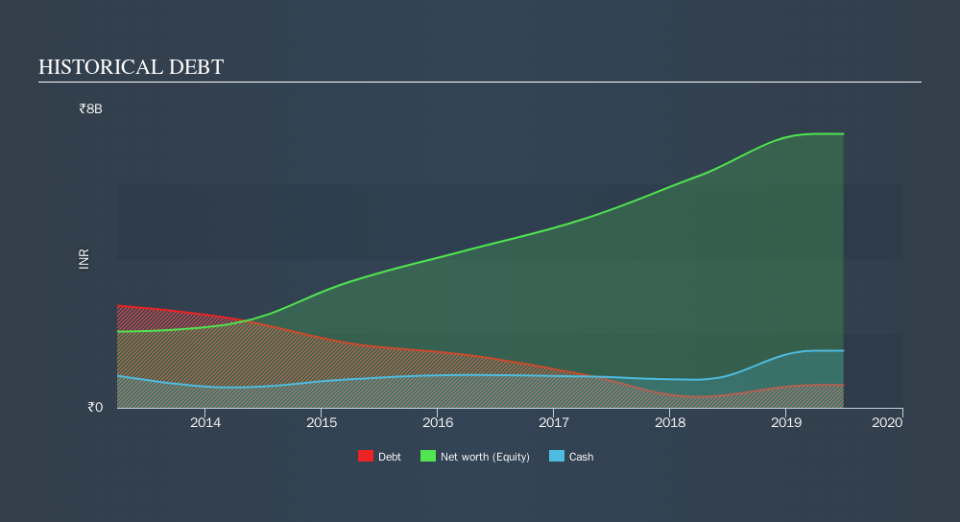We Think Ahluwalia Contracts (India) (NSE:AHLUCONT) Can Stay On Top Of Its Debt

Warren Buffett famously said, 'Volatility is far from synonymous with risk.' So it might be obvious that you need to consider debt, when you think about how risky any given stock is, because too much debt can sink a company. We can see that Ahluwalia Contracts (India) Limited (NSE:AHLUCONT) does use debt in its business. But the real question is whether this debt is making the company risky.
When Is Debt A Problem?
Generally speaking, debt only becomes a real problem when a company can't easily pay it off, either by raising capital or with its own cash flow. Ultimately, if the company can't fulfill its legal obligations to repay debt, shareholders could walk away with nothing. However, a more common (but still painful) scenario is that it has to raise new equity capital at a low price, thus permanently diluting shareholders. Of course, the upside of debt is that it often represents cheap capital, especially when it replaces dilution in a company with the ability to reinvest at high rates of return. When we examine debt levels, we first consider both cash and debt levels, together.
Check out our latest analysis for Ahluwalia Contracts (India)
What Is Ahluwalia Contracts (India)'s Net Debt?
The image below, which you can click on for greater detail, shows that at March 2019 Ahluwalia Contracts (India) had debt of ₹611.1m, up from ₹298.0m in one year. But on the other hand it also has ₹1.53b in cash, leading to a ₹917.7m net cash position.
How Strong Is Ahluwalia Contracts (India)'s Balance Sheet?
According to the last reported balance sheet, Ahluwalia Contracts (India) had liabilities of ₹6.80b due within 12 months, and liabilities of ₹679.7m due beyond 12 months. On the other hand, it had cash of ₹1.53b and ₹6.54b worth of receivables due within a year. So it actually has ₹582.2m more liquid assets than total liabilities.
This surplus suggests that Ahluwalia Contracts (India) has a conservative balance sheet, and could probably eliminate its debt without much difficulty. Simply put, the fact that Ahluwalia Contracts (India) has more cash than debt is arguably a good indication that it can manage its debt safely.
On the other hand, Ahluwalia Contracts (India) saw its EBIT drop by 9.4% in the last twelve months. If earnings continue to decline at that rate the company may have increasing difficulty managing its debt load. There's no doubt that we learn most about debt from the balance sheet. But ultimately the future profitability of the business will decide if Ahluwalia Contracts (India) can strengthen its balance sheet over time. So if you want to see what the professionals think, you might find this free report on analyst profit forecasts to be interesting.
Finally, a business needs free cash flow to pay off debt; accounting profits just don't cut it. Ahluwalia Contracts (India) may have net cash on the balance sheet, but it is still interesting to look at how well the business converts its earnings before interest and tax (EBIT) to free cash flow, because that will influence both its need for, and its capacity to manage debt. Looking at the most recent three years, Ahluwalia Contracts (India) recorded free cash flow of 40% of its EBIT, which is weaker than we'd expect. That weak cash conversion makes it more difficult to handle indebtedness.
Summing up
While it is always sensible to investigate a company's debt, in this case Ahluwalia Contracts (India) has ₹917.7m in net cash and a decent-looking balance sheet. So we are not troubled with Ahluwalia Contracts (India)'s debt use. Over time, share prices tend to follow earnings per share, so if you're interested in Ahluwalia Contracts (India), you may well want to click here to check an interactive graph of its earnings per share history.
If, after all that, you're more interested in a fast growing company with a rock-solid balance sheet, then check out our list of net cash growth stocks without delay.
We aim to bring you long-term focused research analysis driven by fundamental data. Note that our analysis may not factor in the latest price-sensitive company announcements or qualitative material.
If you spot an error that warrants correction, please contact the editor at editorial-team@simplywallst.com. This article by Simply Wall St is general in nature. It does not constitute a recommendation to buy or sell any stock, and does not take account of your objectives, or your financial situation. Simply Wall St has no position in the stocks mentioned. Thank you for reading.


